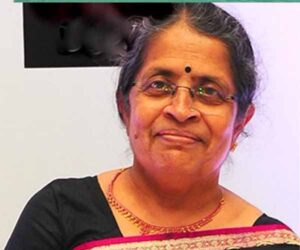History of CHEP – Padma Shri. Rohini M. Godbole

The story of Women at the erstwhile CTS, now CHEP: The Centre for Theoretical Studies(CTS) founded in 1972 . Prof. Sulochana Gadgil was one of the early faculty of of CTS. In those days the CTS faculty could not take students, but had a very vibrant visitors’ program. Among long term visitors to the centre there were a few women physicists like Prof. Bhamathi from Physics Department of Madras University and Prof. Prema from Bharatidasan University at Trichy. In addition there were also Ph.D. students like Somdatta Sinha (from JNU) and Lalitha Vijayan, Priya Davidar of BNHS and doctoral Students of Dr. Salim Ali, who spent significant period collaborating with CTS faculty, all moving on to very successful scientific careers at different places in India. Prof. Sulochana Gadgil had a number of women research assistants who were more like students and were coauthors in her publication. Many of them went on to do their Ph.D. and have had successful scientific careers either in India or abroad. Thus there were women like R. Gowri, Asharani, Dr. Madhulika Sinha, Dr. Malati Hegde and Savita Bhagwan-Shastri. who worked on projects in CTS, majority of them with Prof. Sulochana Gadgil, and went on to lead successful scientific careers. So traditionally there has been a presence of women at the CTS. Who knows, the presence of a woman faculty may have indirectly helped it! After the formation of the Centres for Ecological Sciences (CES) and Centre for Atmospheric and Oceanic Sciences(CAOS) in early 1980’s, faculty that remained at CTS consisted of theoretical physicists working mainly on quantum field theory, particle physics and mathematical physics. CTS in this avatar had only one woman faculty, working in theoretical particle physics, who joined in 1994. The total number of faculty at the centre at that time stood at 6. So if one calculated percentages it was a healthy 16%! The centre had to wait till 2016 when it got its second woman faculty. By this time the centre had been rechristened in 2004 as the Centre for High Energy Physics and had hired in 2016 its first faculties in experimental high energy physics. At present the centre has one woman faculty among a total of 14 (and 2 in a total of 16 if we count also the INSA senior scientists at the centre) so a mere 7% (12%), around 10 % or so. Due to the small absolute numbers these percentages do not mean much any way!
Till early 1990’s CTS faculty could still not take Ph.D. students directly and some guided Ph.D. students who were admitted in Physics Department. One of them was Rajalaxmi a physics Ph.d student who worked with Prof. R. Rajaraman who afterwords had a career in scientific publication and was involved with the Journal of Science Education, Resonance and another was R. Chitra who worked for her Ph.D. with Prof. Sen during 1991-1996 who is now pursuing a successful academic career in France. In fact, as a joke, for a while people would call CTS as Chitra Training School because for a short period she was the only student working with a CTS faculty! After CTS started admitting its own Ph.D. students there have been a small number of women students, coming to CTS both through the Post M.Sc. stream and the I.Ph.D. stream. One can see the names of the women alumni including the Ph.D. students and post doctoral fellows on the web page. One can see that it has been growing steadily but still less than 10% overall. Interesting to note that the women students and mentees have been associated mostly with male faculty. However, at the same time it is clear that the numbers do not exactly support the belief that women do not/can not do physics and theoretical physics at that!
To hear more directly from Women in CHEP –Click Here